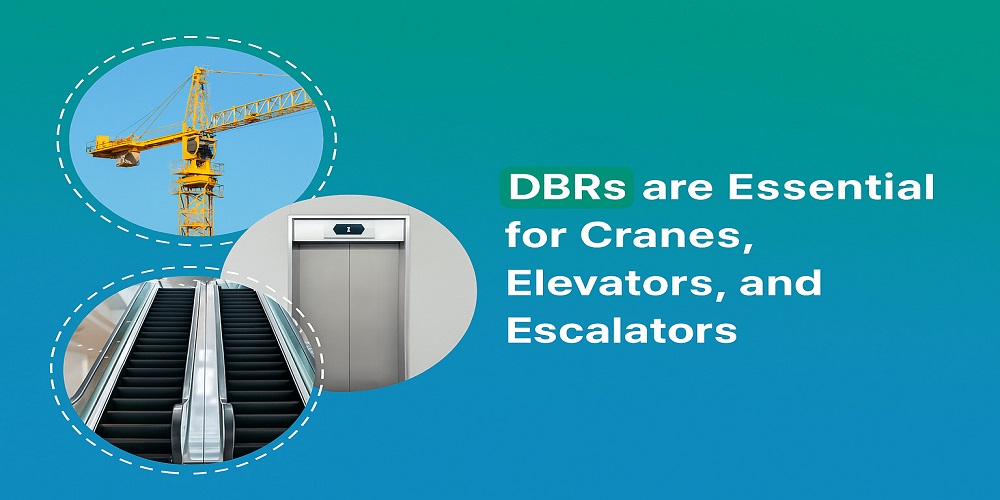
Why Dynamic Braking Resistors are Essential for Cranes, Elevators, and Escalators
In today’s rapidly urbanising world, the safe and efficient operation of vertical transport and material handling equipment is non-negotiable. Whether moving people or goods, systems like cranes, elevators, lifts, and escalators require reliable, controlled braking to ensure safety, comfort, and minimal wear on critical components. This is where Dynamic Braking Resistors (DBRs) become indispensable. Supplied by industry leaders such as Cermet Resistronics, DBRs are key to modern safety and performance standards in industrial and building automation.
Understanding Dynamic Braking Resistors
Dynamic Braking Resistors are electrical components designed to safely absorb and dissipate the excess electrical energy generated when an electric motor slows down or stops. In systems controlled by Variable Frequency Drives (VFDs), such as cranes, lifts, elevators, and escalators, the motor often acts as a generator during deceleration, creating a surge of electrical energy that must be managed effectively to avoid equipment damage or failure.
The Need for Dynamic Braking in Industrial Applications
What Happens During Braking?
When a crane, elevator, lift, or escalator motor decelerates, the kinetic energy stored in the moving load does not simply disappear. Instead, this energy is converted into electrical energy by the motor and returned to the VFD’s DC bus. If left unchecked, this can create voltage surges, damage electronic components, and compromise overall safety.
The Role of the Dynamic Braking Resistor
A Dynamic Braking Resistor steps in during such events, channelling excess energy away from sensitive components and turning it into harmless heat. This enables controlled, smooth stops and helps protect both passengers and the expensive equipment in use.
Why DBRs are Vital in Cranes
- Prevention of Overrun and Overspeed: Cranes are responsible for moving heavy loads both vertically and horizontally. During lowering operations, the crane motor often generates more power than needed, especially when the load is significant. Without a DBR, this can cause uncontrolled descent or overrun, risking both safety and structural integrity.
- Enhanced Control: DBRs allow for precise stopping and holding, limiting dangerous swings and ensuring load placement exactly where required.
- Reduced Mechanical Wear: By handling most of the kinetic energy electrically rather than through friction brakes, DBRs markedly extend the life of crane braking systems.
The Importance of DBRs in Elevators and Lifts
- Smooth and Safe Stops: Elevators and lifts routinely carry people and sensitive cargo. A DBR for Elevator guarantees each journey finishes with a smooth, comfortable stop, preventing sudden jerks or mechanical stress.
- Continuous Protection: When descending fully loaded, the electrical energy generated can spike. The DBR for Lift absorbs this, avoiding dangerous voltage levels and protecting the drive electronics.
- Compliance with Modern Standards: In emergency or maintenance scenarios, DBRs complement mechanical brakes to provide dual redundancy, enhancing safety for all users.
Escalators: Managing Continuous Loads
Escalators are under constant operation, frequently stopping and starting as passengers get on and off. During each deceleration, the system creates excess kinetic energy. Here’s how a Dynamic Braking Resistor for Escalators helps:
- Prevents Overheating: It disperses the generated energy as heat quickly, preventing damage to VFDs and other components.
- Smooth Deceleration: DBRs ensure that speed changes remain gentle, safeguarding passenger comfort and reducing mechanical strain.
Key Benefits of Using Dynamic Braking Resistors
| Benefit | Application |
| Enhanced safety | Prevents uncontrolled movements |
| Reduced equipment wear | Limit the use of mechanical brakes |
| Greater operational efficiency | Faster, more reliable stop cycles |
| Energy management | Handles regenerative energy smartly |
| Cost savings | Lowers maintenance and downtime |
| Compliance and flexibility | Meets regulatory standards |
Cermet Resistronics: A Reliable Partner
When selecting a Dynamic Braking Resistor for Crane, Dynamic Braking Resistor for Elevator, Dynamic Braking Resistor for Lift, or Dynamic Braking Resistor for Escalators, it’s vital to choose a dependable supplier. Cermet Resistronics offers:
- Customisable solutions to match the power and duty cycle of your specific application.
- High-quality construction with robust heat dissipation, ensuring durability in challenging environments.
- Technical support for installation and maintenance, minimising downtime and maximising operational reliability.
Choosing the Right DBR
Different applications and equipment have unique needs. Factors to consider when choosing a Dynamic Braking Resistor include:
- Power Rating: Must handle the maximum possible surge during an emergency stop.
- Ohmic Value: Should match the requirements defined by the VFD and motor combination.
- Thermal Design: Needs to dissipate heat effectively, especially in small or enclosed spaces.
- Compliance: Ensure meeting all local and international safety standards.
Best Practices for Longevity and Safety
- Install in well-ventilated locations to allow heat dissipation.
- Conduct routine inspections for wear, overheating, or signs of fatigue.
- Follow manufacturer guidance from Cermet Resistronics for safe installation and operational parameters.
Conclusion
Dynamic Braking Resistors are a cornerstone of safety, reliability, and efficiency in the movement and lifting of people and materials. Whether safeguarding a passenger lift, ensuring the precise placement of heavy loads on a crane, or maintaining smooth operation of an escalator, DBRs, especially those engineered by Cermet Resistronics, are essential for modern urban mobility and industry. Investing in the right DBR not only protects your equipment but also affirms your commitment to safety and quality in every journey and every lift.

